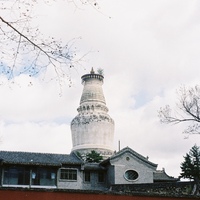Mount Wutai, also known as Mount Qingliang or Mount Wufeng, is a sacred site for Buddhism located in the northeastern part of Shanxi Province at the northern end of the Mount Taihang range. It is the only Buddhist site in China where both Qing ("green") and Huang ("yellow") temples coexist. Mount Wutai once exceeded Tibet in attracting pilgrims from various schools of Buddhism and multiple ethnic groups due to its ideal geographical circumstances. Nowadays, Mount Wutai has developed into a unique religious location where both Mongolians, Tibetans, and other minorities live. This group of multi-ethnic Buddhist adherents, who reside in Taihuai Town, play a crucial role in the community's social activities.
In both historical and contemporary contexts, Mount Wutai enjoys a special status as a Buddhist "holy mountain." As the hub of Mount Wutai's picturesque area, the town of Taihuai serves as the cultural and administrative center of Mount Wutai region. Taihuai Town hosts the majority of various events and festivals relating to Buddhism and local folklore. Understanding Taihuai Town is essential to comprehend Mount Wutai.

